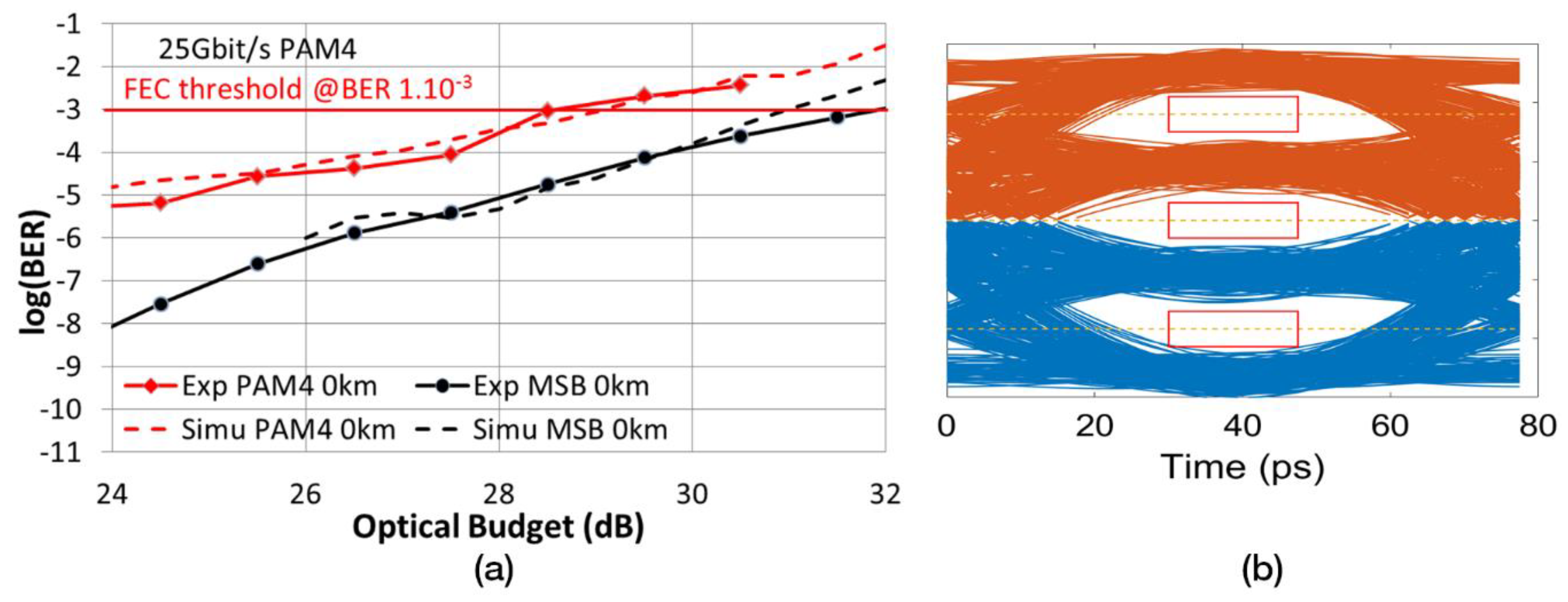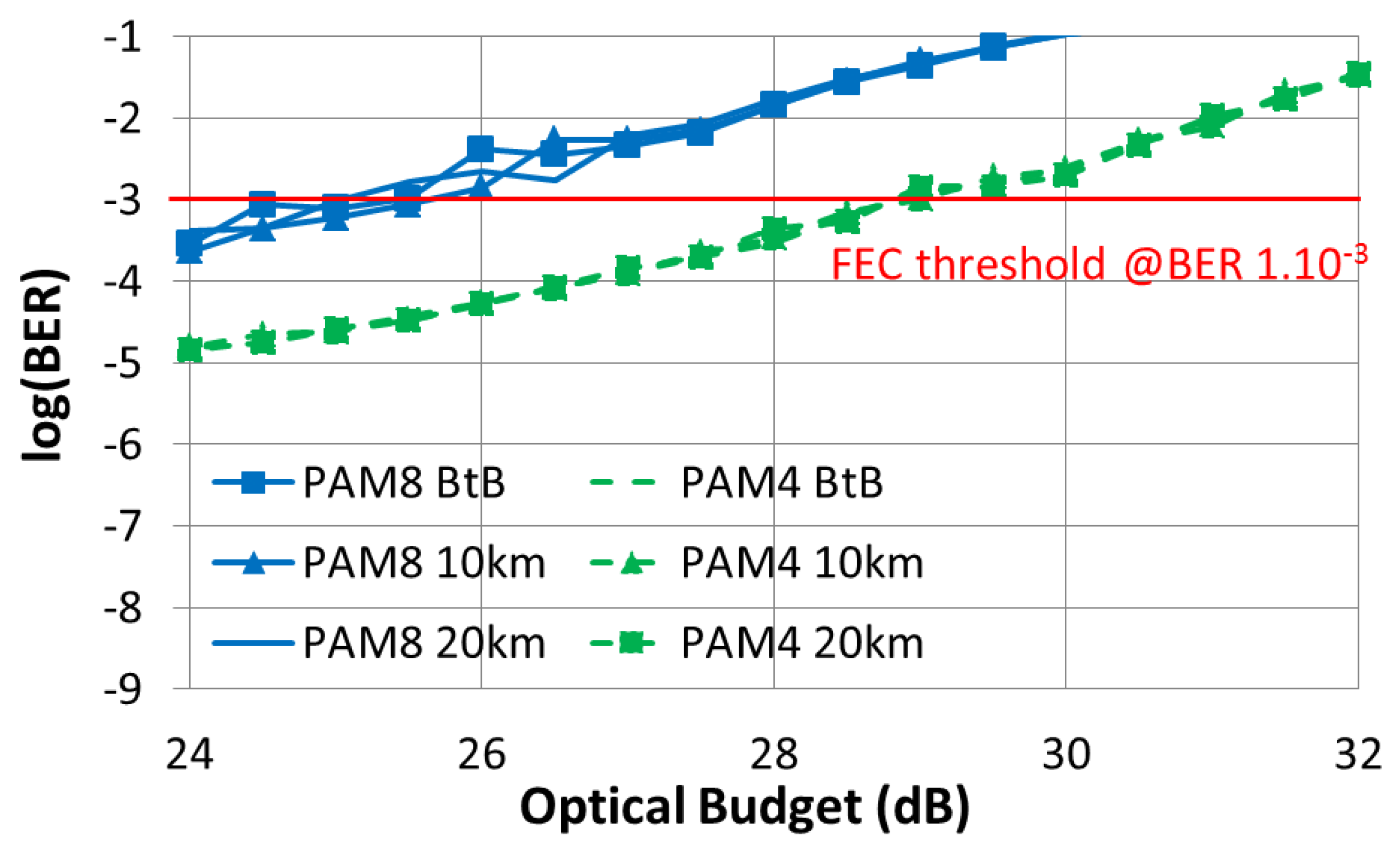TDM-PON PAM Downstream Transmission for 25 Gbit/s and Beyond
Abstract
:1. Introduction
2. Simulation Setup
3. Simulation Results
3.1. Simulation Model Fine-Tuning
3.2. 37.5 Gbit/s PAM8
3.3. 50 Gbit/s PAM4
4. Conclusions
Author Contributions
Funding
Conflicts of Interest
References
- Amendment 1: Physical Layer Specification and Management Parameters for 10Gb/s Passive Optical Networks; IEEE 802.3av-2009; IEEE Standards Association: Piscataway, NJ, USA, 2009.
- 10-Gigabit-Capable Symmetric Passive Optical Network (XGS-PON); ITU-T G9807.1; International Telecommunication Union: Geneva, Switzerland, 2016.
- PON Transmission Technologies above 10 Gbit/s per Wavelength; G.sup64; International Telecommunication Union: Geneva, Switzerland, 2018.
- Chanclou, P.; Neto, L.A.; Grzybowski, K.; Tayq, Z.; Saliou, F.; Genay, N. Mobile Fronthaul Architecture and Technologies: A RAN Equipment Assessment. J. Opt. Commun. Netw. 2018, 10, A1–A7. [Google Scholar] [CrossRef]
- 40-Gigabit-Capable Passive Optical Networks 2 (NG-PON2); ITU-T G989.2; International Telecommunication Union: Geneva, Switzerland, 2016.
- Van Veen, D.; Houtsma, V. Bi-directional 25G/50G TDM-PON with extended power budget using 25G APD and coherent amplification. In Proceedings of the Optical Fiber Communication Conference 2017, Los Angeles, CA, USA, 19–23 March 2017; pp. 1–3. [Google Scholar]
- Zhicheng, Y.; Jing, D.; Shengping, L.; Konopacki, J.; Saliou, F.; Le Guyader, B.; Barthomeuf, S.; Chanclou, P.; Erasme, D. Fabry-Perot Filtered Emission for 25 Gbit/s Single-Side Band NRZ and ODB Transmissions in C-band up to 20 km. In Proceedings of the 2017 European Conference on Optical Communication (ECOC), Goteborg, Sweden, 17–21 September 2017. [Google Scholar]
- Konopacki, J.; Le Guyader, B.; Genay, N.; Neto, L.A.; Saliou, F.; Barthomeuf, S.; Chanclou, P.; Erasme, D. Real-Time 20 and 25 Gbit/s Pre-Equalized C-band Transmission with Electrical Duo-binary Detection. In Proceedings of the 2017 European Conference on Optical Communication (ECOC), Goteborg, Sweden, 17–21 September 2017. [Google Scholar]
- Van Der Linden, R.; Tran, N.C.; Tangdiongga, E.; Koonen, A.M. Improvement on Received Optical Power Based Flexible Modulation in a PON by the Use of Non-Uniform PAM. In Proceedings of the 2017 European Conference on Optical Communication (ECOC), Goteborg, Sweden, 17–21 September 2017. [Google Scholar]
- Miao, X.; Bi, M.; Fu, Y.; Li, L.; Hu, W. Experimental Study of NRZ, Duobinary, and PAM-4 in O-Band DML-Based 100G-EPON. IEEE Photonics Technol. Lett. 2017, 29, 1490–1493. [Google Scholar] [CrossRef]
- Barthomeuf, S.; Saliou, F.; Neto, L.A.; Le Guyader, B.; Chanclou, P.; Erasme, D. Real-time Downstream 25Gbit/s PAM4 for High Speed TDM-PONs with both 25 and 12.5Gbit/s ONUs. In Proceedings of the Optical Fiber Communication Conference 2018, San Diego, CA, USA, 11–15 March 2018; pp. 1–3. [Google Scholar]
- Nagarajan, R.; Filer, M.; Fu, Y.; Kato, M.; Rope, T.; Stewart, J. Silicon Photonics-Based 100 Gbit/s, PAM4, DWDM Data Center Interconnects. J. Opt. Commun. Netw. 2018, 10, B25–B36. [Google Scholar] [CrossRef]
- Kong, M.; Chen, Y.; Sarwar, R.; Sun, B.; Cong, B.; Xu, J. Optical superimposition-based PAM-4 signal generation for visible light communication. In Proceedings of the 2017 16th International Conference on Optical Communications and Networks (ICOCN), Wuzhen, China, 7–10 August 2017. [Google Scholar]
- Wei, J.; Eiselt, N.; Griesser, H.; Grobe, K.; Eiselt, M.H.; Olmos, J.J.; Monroy, I.T.; Elbers, J.P. Demonstration of the First Real-Time End-to-End 40-Gb/s PAM-4 for Next-Generation Access Application Using 10-Gb/s Transmitter. J. Lightwave Technol. 2016, 34, 1628–1635. [Google Scholar] [CrossRef]
- Ye, C.; Hu, X.; Zhang, K. Demonstration and Analysis on PAM-4/8, DBPAM-2/4 and DMT Formatted TDMPON 25Gbps, 40Gbps, 50Gbps Capacity per Lane using Economical 10 Gbps Transceivers. In Proceedings of the European Conference on Optical Communication, Düsseldorf, Germany, 18–22 September 2016; pp. 427–429. [Google Scholar]
- Chen, J.; Tan, A.; Li, Z.; Guo, Y.; Yin, Y.; Zhang, Q.; Song, Y.; Li, Y.; Wang, M. Adaptive Equalization Enabled 25Gb/s NRZ Modulation Based on 10-G Class Optics for Upstream Burst-Mode Transmission. In Proceedings of the Optical Fiber Communication Conference 2018, San Diego, CA, USA, 11–15 March 2018. [Google Scholar]
- Houtsma, V.; van Veen, D. Bi-Directional 25G/50G TDM-PON With Extended Power Budget Using 25G APD and Coherent Detection. J. Lightwave Technol. 2018, 36, 122–127. [Google Scholar] [CrossRef]
- Ye, C.; Zhang, D.; Huang, X.; Feng, H.; Zhang, K. Demonstration of 50Gbps IM/DD PAM4 PON over 10GHz Class Optics Using Neural Network Based Nonlinear Equalization. In Proceedings of the 2017 European Conference on Optical Communication (ECOC), Gothenburg, Sweden, 17–21 September 2017. [Google Scholar]
- Szczerba, K.; Westbergh, P.; Karout, J.; Gustavsson, J.S.; Haglund, Å.; Karlsson, M.; Andrekson, P.A.; Agrell, E.; Larsson, A. 4-PAM for high-speed short-range optical communications. IEEE/OSA J. Opt. Commun. Netw. 2012, 4, 885–894. [Google Scholar] [CrossRef]
- Neto, L.A.; Erasme, D.; Genay, N.; Chanclou, P.; Deniel, Q.; Traore, F.; Anfray, T.; Hmadou, R.; Aupetit-Berthelemot, C. Simple Estimation of Fiber Dispersion and Laser Chirp Parameters Using the Downhill Simplex Fitting Algorithm. J. Lightwave Technol. 2016, 31, 334–342. [Google Scholar] [CrossRef]
- Agrawal, G.P. Fibre-Optic Communication Systems, 3rd ed.; Wiley: New York, NY, USA, 2002; pp. 77–182. [Google Scholar]







| Parameter | Value |
|---|---|
| PRBS data sequence length | 215 − 1 (PRBS15) |
| Modulation formats | PAM4 {PAM8} |
| Laser | DFB directly modulated |
| Wavelength | 1311.36 nm |
| Chirp parameter α | 3 |
| Chirp parameter fc | 2 GHz |
| Bandwidth | 10 GHz {20 GHz} at 90 mA bias |
| Electro-optical conversion efficiency | 0.15 mW/mA |
| Threshold current | 27.8 mA |
| Saturation current | 138 mA |
| RIN | −110 dBm (AWGN) |
| Photodiode + TIA | APD |
| Responsivity | 0.8 A/W |
| Bandwidth | 8.5 GHz {21 GHz} |
| Transimpedance gain | 36 dB |
| Fiber | SMF |
| Length | 0, 10, or 20 km |
| Attenuation | 0.4 dB/km |
| Dispersion | 0 ps/nm/km |
© 2018 by the authors. Licensee MDPI, Basel, Switzerland. This article is an open access article distributed under the terms and conditions of the Creative Commons Attribution (CC BY) license (http://creativecommons.org/licenses/by/4.0/).
Share and Cite
Barthomeuf, S.; Saliou, F.; Anet Neto, L.; Chanclou, P.; Erasme, D. TDM-PON PAM Downstream Transmission for 25 Gbit/s and Beyond. Photonics 2018, 5, 45. https://doi.org/10.3390/photonics5040045
Barthomeuf S, Saliou F, Anet Neto L, Chanclou P, Erasme D. TDM-PON PAM Downstream Transmission for 25 Gbit/s and Beyond. Photonics. 2018; 5(4):45. https://doi.org/10.3390/photonics5040045
Chicago/Turabian StyleBarthomeuf, Sylvain, Fabienne Saliou, Luiz Anet Neto, Philippe Chanclou, and Didier Erasme. 2018. "TDM-PON PAM Downstream Transmission for 25 Gbit/s and Beyond" Photonics 5, no. 4: 45. https://doi.org/10.3390/photonics5040045
APA StyleBarthomeuf, S., Saliou, F., Anet Neto, L., Chanclou, P., & Erasme, D. (2018). TDM-PON PAM Downstream Transmission for 25 Gbit/s and Beyond. Photonics, 5(4), 45. https://doi.org/10.3390/photonics5040045





